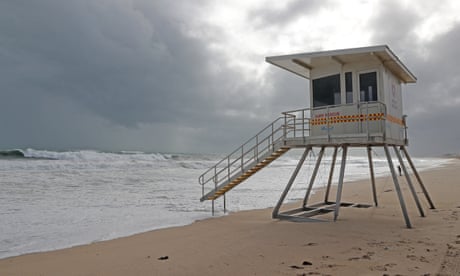- by foxnews
- 08 Apr 2025
Australia’s drowning crisis: why rescuers often perish trying to save family members
Australia’s drowning crisis: why rescuers often perish trying to save family members
- by theguardian
- 08 Jan 2023
- in news

At least two Australians and a New Zealander have drowned within a week this summer while trying to save a family member. Experts say it is an alarming number, compared with the normal annual tally of about six, and the causes of such incidents are tragically familiar.
"Now is a really high-risk period," says Amy Peden, a water safety expert and researcher at the University of NSW.
She says that it is relatively common that the person attempting the rescue drowns while the person who initially got caught in the water survives.
This was the case with off-duty police officer Sgt Peter Stone, 45, who drowned on Monday while trying to rescue his 14-year-old son at a beach south of Narooma, NSW.
Stone managed to push his son to safety but did not survive, despite the efforts of lifesavers who performed CPR.
On Tuesday another man, 42, died after trying to rescue his teenage daughter from a rip at Black Head, 75km south of Port Macquarie.
A nearby surfer took the girl to shore and returned to bring the man back to the beach. Bystanders performed CPR until paramedics arrived but he could not be revived.
On Thursday a New Zealand woman, 52, drowned while trying to save her 11-year-old daughter from a strong lagoon current in the Cook Islands.
And on Victoria's Mornington Peninsula on Friday evening, a 20-year-old man and his 16-year-old brother got into trouble swimming at the notorious Gunnamatta Beach.
Seeing they were struggling in heavy surf and strong winds, the boys' father swam out to assist them. Emergency services rescued the father and his younger son, but the older son has not been found, despite an extensive search into Saturday.
Peden says bystander drownings often involve a parent trying to help a child.
"It's often a parent going in to rescue a child or rescuing someone they know, as opposed to a stranger," she says.
She says on average Australians will perform one rescue in their life - so it is vital to know how to handle the situation.
Peden says "a few different things can go wrong" to put the rescuer into an unsafe situation, but typically they simply become exhausted.
"The adrenaline wears off, the exhaustion kicks in, the effort it takes to get out to someone - to make sure they're OK and keep them above water, the exertion of it, with people grabbing on to you - is too much."
Peden says it's natural for parents not to think twice before entering the water to try to rescue a child "in the heat of the moment", but having that second thought can make the difference between life and death.
The first possibility is simply to call for help if others are around. Then, crucially, if you do go into the water alone, "taking something that floats - a boogie board, a pool noodle, an eski, they might have a two-litre bottle of drinking water - anything that can hold air".
"You'll need that flotation when you perform the rescue."
Prof Rob Brander of UNSW - known as Dr Rip for his research using dyes in the surf to teach rip awareness - echoes that advice.
"We've done surveys of people involved in bystander rescues and looking at the fatalities, the main theme that came out is that people didn't bring a flotation device. If they did, it was a successful rescue."
Both researchers stress that precautions and some beach knowledge are an essential safeguard against bystander drownings. Both of the recent cases in Australia were at unpatrolled beaches and involved rips, Peden says.
"Knowing how to spot a rip is important and choosing to swim at a controlled location - it won't be an untrained bystander going in to rescue if there are trained life savers."
Brander says spotting a rip can be difficult, but is essential in saving lives.
"They have different visual types of characteristics, but the more common rips are easier to spot," Brander said.
"They sit in deep channels, the water is deeper and darker and not as many waves break there. If you're looking along the beach, they'll appear like narrow green paths heading offshore between the white water."
He says if anyone gets caught in a rip, the best thing to do is to float: the rip will eventually end and they can swim back in. But with the added exhaustion of trying to help a second person, the instinct to fight the rip can be fatal.
Over the past 10 years, an average of 26 people each year have died because they did not know what to do in a rip, but Brander says the number is likely to be a lot higher.
"You're probably looking at 30 people each year - that's more than people who have been killed by floods or sharks, it's a big hazard."
- by foxnews
- descember 09, 2016
Ancient settlement reveals remains of 1,800-year-old dog, baffling experts: 'Preserved quite well'
Archaeologists have recently unearthed the remarkably well-preserved remains of a dog from ancient Rome, shedding light on the widespread practice of ritual sacrifice in antiquity.
read more


